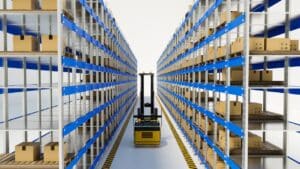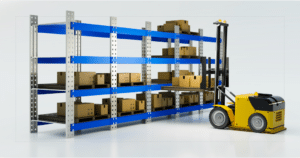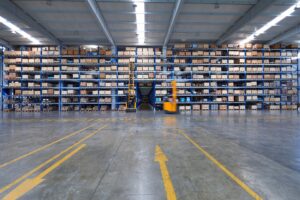Speed and efficiency are very important for keeping production running smoothly. One of the key technologies that help businesses streamline their packaging process is the high-speed inline palletizer. This machine is designed to automate the stacking of products onto pallets, significantly improving efficiency, reducing labor costs, and minimizing errors.
What is a High-Speed Inline Palletizer?
A high-speed inline palletizer is an automated system that arranges and stacks products onto a pallet in a continuous and high-speed manner. It is designed to work as part of a production line, quickly organizing products into specific patterns before placing them onto pallets. This type of palletizer is commonly used in industries such as food and beverage, pharmaceuticals, and consumer goods, where efficiency and speed are essential for large-scale production.
Unlike traditional palletizing methods, a high-speed inline palletizer operates automatically with minimal human involvement, reducing labor costs and increasing productivity. It uses conveyor belts, sensors, and robotic arms to precisely position and stack items, ensuring stability and uniformity. Some models also include features like stretch wrapping and labeling to prepare pallets for shipping. By streamlining the packaging process, these palletizers help businesses improve efficiency, minimize product damage, and meet high-demand production requirements.
How Does a High-Speed Inline Palletizer Work?
The operation of a high-speed inline palletizer follows a structured process:
- Product Infeed: Products arrive at the palletizer through a conveyor system. The machine detects and organizes them according to a pre-programmed pattern.
- Sorting and Layer Formation: The palletizer arranges products into specific layers using sensors and robotic arms to ensure proper alignment.
- Pallet Placement: An empty pallet is positioned at the base of the palletizing area.
- Stacking Process: The machine continuously stacks the layers on top of each other, ensuring stability and precision.
- Final Output: Once the pallet is fully loaded, it is transferred to the next stage, such as wrapping or shipping.
This entire process is completed in a matter of seconds, making it ideal for high-volume production lines.
Types of In-Line Palletizers
In-line palletizers are automated systems designed to efficiently stack products onto pallets in a streamlined production process. These machines vary based on speed, product type, and facility space, making them suitable for different industries. The main types of in-line palletizers include high-level, low-level, and robotic palletizers.
- High-Level In-Line Palletizers
High-level in-line palletizers are designed to receive products at an elevated position before stacking them onto pallets. They are widely used in high-speed production environments where continuous product flow is essential. These palletizers ensure smooth and efficient stacking while minimizing manual labor.
- Operate from an elevated position where products are fed at a higher level.
- Suitable for high-speed production lines.
- Efficient for stacking lightweight and uniform products.
- Low-Level In-Line Palletizers
Low-level in-line palletizers function at ground level, making them ideal for facilities with space constraints. These palletizers provide easy access for maintenance and operation while maintaining efficiency in stacking products. Their design allows for seamless integration into production lines with lower conveyor heights.
- Products are fed at ground level before being stacked.
- Commonly used in facilities with limited space.
- Easier maintenance due to ground-level access.
- Robotic In-Line Palletizers
Robotic in-line palletizers utilize advanced robotic arms to handle products with precision and flexibility. They are ideal for businesses that deal with a variety of product shapes, sizes, and packaging styles. These palletizers improve efficiency while reducing manual handling and the risk of product damage.
- Use robotic arms to pick and place products onto pallets.
- Offer flexibility in handling different product shapes and sizes.
- Ideal for businesses with diverse product lines.
Each type of in-line palletizer has distinct benefits depending on the production environment, budget, and facility layout. Choosing the right palletizer ensures optimized workflow, increased efficiency, and improved product handling in manufacturing and distribution operations.
Key Features of High-Speed Inline Palletizers
To maximize efficiency, modern high-speed inline palletizers are equipped with advanced features, including:
1. Robotic or Conventional Palletizing Systems: Some machines utilize robotic arms for enhanced flexibility, while others rely on layer-forming techniques to ensure efficient and consistent palletizing. The choice depends on production needs, with robotic systems excelling in adaptability and conventional systems offering structured stacking.
2. High-Speed Processing: These palletizers can handle thousands of products per hour, drastically cutting down packaging time and improving overall throughput. Their rapid operation ensures that manufacturers meet high production demands without bottlenecks.
3. Automated Layer Forming: Precise stacking is achieved through automated layer-forming mechanisms that arrange products systematically. This feature enhances pallet stability, reducing the risk of product damage during transport.
4. Advanced Sensor Technology: Equipped with cameras and motion sensors, these machines make real-time adjustments to maintain accuracy. This technology improves efficiency by detecting misalignments and making necessary corrections instantly.
5. User-Friendly Controls: Intuitive touchscreen interfaces allow operators to easily program and adjust settings as needed. This simplifies machine operation, minimizing training time and human error.
6. Space-Saving Design: Designed to seamlessly integrate into existing production lines, inline palletizers optimize floor space while maintaining high efficiency. Their compact structure ensures they do not disrupt the workflow while enhancing productivity.
Benefits of Using a High-Speed Inline Palletizer
Investing in a high-speed inline palletizer offers numerous advantages:
- Increased Efficiency
By automating the palletizing process, businesses can significantly boost their operational efficiency. High-speed inline palletizers can handle large volumes of products swiftly, reducing downtime and increasing overall throughput. This allows companies to meet high demand while maintaining smooth and uninterrupted workflow.
- Reduced Labor Costs
Manual palletizing requires multiple workers, leading to higher labor costs and potential inefficiencies. By using an inline palletizer, businesses can reduce dependency on manual labor, freeing up employees to focus on more valuable tasks. This not only lowers operational costs but also optimizes workforce allocation for better productivity.
- Enhanced Product Safety
Proper stacking and precise alignment minimize the risk of product damage during handling and transportation. An inline palletizer ensures uniform stacking, reducing product losses due to mishandling. This enhances customer satisfaction as goods arrive in perfect condition, maintaining brand reputation and reducing returns.
- Improved Workplace Safety
Heavy lifting and repetitive manual stacking can lead to workplace injuries, including muscle strains and back problems. Automating the palletizing process eliminates these risks, providing a safer working environment. This reduces workers’ compensation claims and improves overall employee well-being, leading to higher job satisfaction.
- Scalability
As businesses grow, their palletizing needs evolve, requiring flexible solutions. Inline palletizers can adapt to various product sizes and configurations, making them an ideal choice for expanding operations. This scalability allows businesses to increase production capacity without frequent equipment upgrades, ensuring long-term efficiency and cost-effectiveness.
Industries That Benefit from High-Speed Inline Palletizers
Several industries rely on high-speed inline palletizers to improve their packaging and distribution processes:
- Food and Beverage: These palletizers streamline the packaging of bottled drinks, packaged foods, and dairy products, ensuring faster processing and reduced handling time. Their efficiency helps maintain product integrity while meeting high consumer demand.
- Pharmaceuticals: High-speed palletizers ensure the safe and precise stacking of medical supplies and pharmaceutical products. This reduces contamination risks and maintains compliance with strict industry regulations.
- Consumer Goods: From household essentials to electronics, these machines speed up packaging processes, improving supply chain efficiency. Their automation reduces labor costs while ensuring consistent product handling.
- Logistics and Warehousing: Inline palletizers play a crucial role in the smooth movement of packaged goods in distribution centers. They enhance storage efficiency and accelerate shipment preparation, optimizing overall logistics operations.
Conclusion
A high-speed inline palletizer is a game-changer for businesses that require fast, efficient, and reliable palletizing solutions. By automating the stacking process, companies can improve productivity, reduce labor costs, and ensure product safety. When selecting the right palletizer for your needs, consider factors like speed, flexibility, and space requirements. Regular maintenance and operator training will ensure long-term efficiency and cost savings.
If you are looking for packaging solutions, AFA Systems has the right options for you. Our case packers, cartoners, and tray packers help automate packing, making the process smooth and efficient. We also offer carton formers, case erectors and sealers to shape, build, and seal packaging with ease. At AFA Systems, we provide smart automation to make packaging faster and more reliable.







